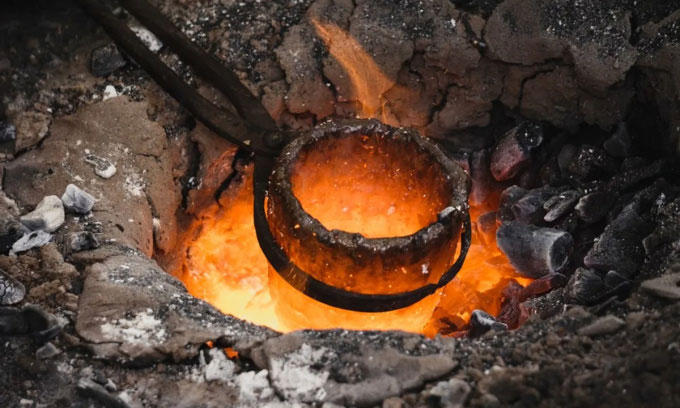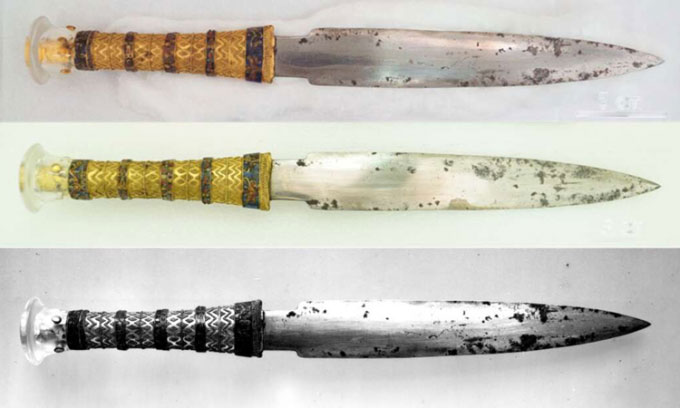How did prehistoric people make metal objects?
5,000 years ago, people moved from the Stone Age to the Bronze Age thanks to the advent of metallurgy, separating metals from impurities .
Today, alloys are present in everything from smartphones to spacecraft. They are the latest products of metallurgy that has existed since the Bronze Age, when the first metal mixtures were created. Today, metal mining and processing is a major industry, but pioneers processed metals almost exclusively with ordinary stone and fire tools.

The birth of the copper-tin alloy is one of the most outstanding advances in world history. (Photo: Anna Kepa)
Initially, prehistoric people could only exploit metals in their primary form , meaning they existed in lump form and were not mixed with other elements in rocks. Therefore, they do not need to go through an extraction process but can be collected by sifting in rivers or digging in the soil.
The oldest bronze artifacts date back about 8,000 years , while gold objects appeared several thousand years later. At this time, the technology needed to extract iron from rock had not yet appeared, although the ancient Egyptians had made a number of objects from meteoric iron . They can turn them into knives like the daggers in the tomb of pharaoh Tutankhamun.

Photo taken of both sides of the dagger in King Tutankhamun's tomb in 2020 and photo taken when the knife was first discovered in 1925 (bottom). (Photo: Meteoritics & Planetary Science/Harry Burton).
About 5,000 years ago, humans began to transition from the Stone Age to the Bronze Age, largely thanks to the advent of metallurgy. The process involves heating copper ore in a stone or ceramic pot to separate the metal from impurities.
Although there are no documents on how metallurgy was born, it is likely that the ancients came up with the idea of blowing air through hollow bars to increase the temperature of the furnace , helping to release molten metal. This primitive blacksmith did not know that the carbon in the wood reacts with the oxygen in the ore, converting it to CO 2 and releasing the copper that was bound to it.
Bronze was a suitable metal to use, helping to create new tools and weapons that were much better than the previous material, stone. Copper hardens when struck with a hammer and can be melted and poured into molds to make standard items.
Additionally, copper can be significantly improved by mixing it with tin, forming a new alloy. This metal mixture is not only harder than pure copper when struck with a hammer, but also melts at a much lower temperature, making the casting process easier.
The widespread use of this mixture around 3000 BC marked the beginning of the Bronze Age - a period when many alloys were created when people experimented with adding zinc and other metals to copper. In fact, this testing has never stopped. New alloys continue to appear with many useful applications.
The technological advances of the Bronze Age fueled the rise of the ancient world's most powerful civilizations. However, this era eventually ended when humans figured out how to smelt iron from rock , creating an even more useful material and ushering in the Iron Age.
Originally, ancient furnaces could not reach temperatures high enough to actually melt iron. Therefore, the first blacksmiths had to work with wrought iron - the material obtained when separated from the slag produced by the firing process. Around 300 BC, Chinese metalworkers invented a blowpipe that could create a flame hot enough to melt iron.
What's interesting is that iron is not actually as hard as copper-tin alloy, objects made from iron are often of lower quality than those made of the previous alloy. However, iron is much cheaper to produce than this alloy, mainly because iron is more abundant than tin. Later, iron was also used to create steel - one of the most essential materials of modern times.
- Discover the oldest artificial metal object in the Middle East
- Add strange objects to Yen Bai
- Mysterious objects fall into Myanmar
- The metal sphere fell after the explosion that panicked the Peruvian people
- Additional discovery of the third 'space sphere' in Vietnam
- Video: Use the card to cut off metal cans
- Hero of 1.5kg metal found in a woman's stomach
- What happens if an aluminum object is placed in a microwave oven?
- Add a boy with a metal stick
- The metal '2.8 meteorite' struck the ground
- Can any metal be magnetized like a magnet?
- Footprints of 3.6 million years of prehistoric people reveal many secrets
 Discovered an ancient centipede fossil 99 million years old
Discovered an ancient centipede fossil 99 million years old Discovered bat-like dinosaurs in China
Discovered bat-like dinosaurs in China Discovered a 200-year-old bronze cannon of the coast
Discovered a 200-year-old bronze cannon of the coast Discover 305 million-year-old spider fossils
Discover 305 million-year-old spider fossils